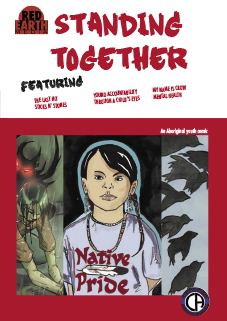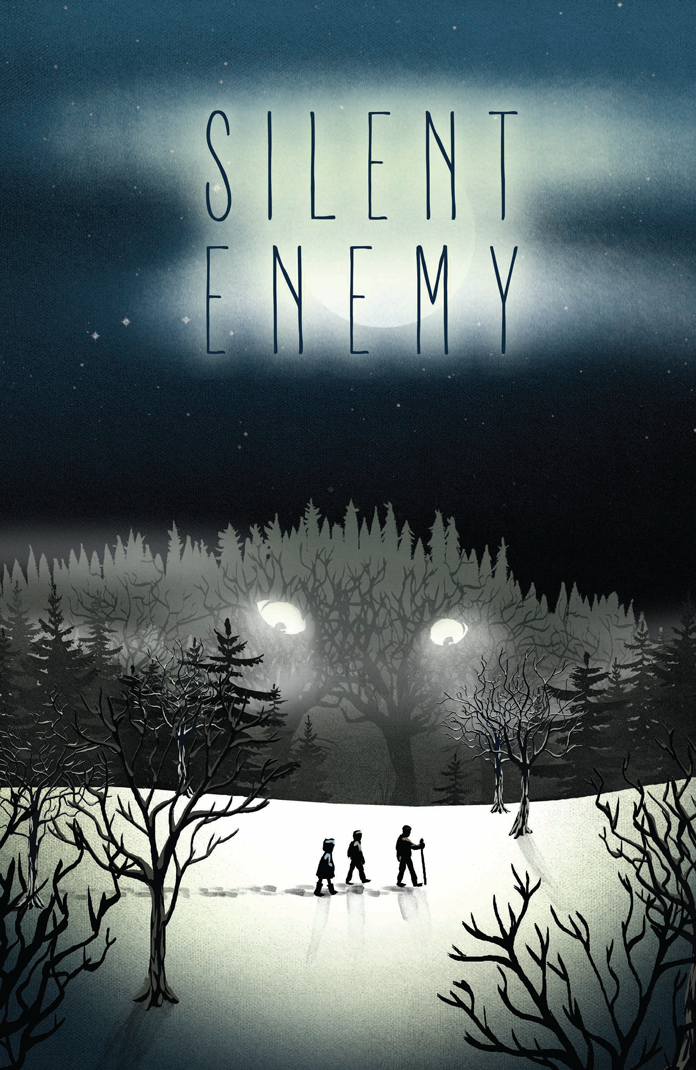New Media
"Aboriginal new media is connected in context and cultural practices as a result of shared socio-cultural experiences. Together, these works bring forth significant accounts that are embodied in our ancient homeland. Our creative expression sustains a connection to ancient ways, places our identities and concerns in the immediate, while linking us to the future. To a broader audience, this expression conveys an Aboriginal worldview, revealing the Aboriginal experience in all its complexities." (From "Content Meets Context" by Melanie Townsend in Transference, Tradition, Technology: Native New Media Exploring Visual & Digital Culture).
Indigenous new media is an evolving, multidisciplinary area of art and scholarly work that broadly encompasses born-digital and interactive story-telling mediums. This can include video games, podcasts, comics, video art, and web art.
Featured New Media
Comic Book: Standing Together (Healthy Aboriginal Network)
Standing Together is an Aboriginal youth comic, created by youth, on the issues that they felt were important to their community.

Zine: Indigi-zine Issue 1: #NODAPL
The first issue of Indigi-zine was “#NoDAPL”, an accompanying zine to a Standing Rock fundraiser festival that took place on December 11, 2016 at Brooklyn’s DIY venue, Silent Barn. It features poetry, photography, artwork, and quotes from native artists and water protectors who were fighting on the front lines.

Movie: Bihttoš (Elle-Máijá Tailfeathers)
In a moving personal essay, Elle-Máijá Tailfeathers examines her complex relationship to her Sámi father.

Book Trailer: Sugar Falls (David Alexander Robertson)
Sugar Falls is a powerful graphic novel that recounts the residential school experience of Betty Ross, an elder from Cross Lake First Nation.

Podcast: Stories from the Land
The Stories from the Land Podcast series is a collection of Indigenous community sourced stories that connect Indigenous Peoples to place with the aim of reinforcing worldview, philosophies and teachings through storytelling.

Comic Book: Silent Enemy (Cancer Care Ontario)
Silent Enemy is a comic designed to provide education and awareness to youth about cancer. It was developed on request of a First Nations community and created in partnership with the First Nations Health Authority (FNHA in BC) and CAREX Canada (a CARcinogen EXposure research group based at Simon Fraser University).

Video and Slideshow: An Evening with Winona LaDuke (Vancouver)
On January 19, 2018, Winona LaDuke—an internationally renowned environmental activist working on issues of sustainable development and renewable energy—gave a public talk in Vancouver, BC.

Book Trailer: The Peacemaker: Thanadelthur (David Alexander Robertson)
The Peacemaker: Thanadelthur is one book in the Tales from Big Spirit series. Tales from Big Spirit is a unique seven-book graphic novel series that delves into the stories of seven great Indigenous heroes from Canadian history—some already well known and others who deserve to be.

Documentary Film: Two Soft Things, Two Hard Things (Mark Kenneth Woods)
"As a small group in Nunavut, Canada prepare for a seminal LGBT Pride celebration in the Arctic, the film explores how colonization and religion have shamed and erased traditional Inuit beliefs about sexuality and family structure and how, 60 years later, a new generation of Inuit are actively "unshaming" their past."

The Grease Trail Digital Storytelling Project
The Grease Trail Digital Storytelling project was situated on unceded territories of Tŝilhqot’in, Dakelh, and Secwépemc First Nations and was a land-based experiential learning opportunity for Indigenous pre-service teachers in rural communities of north-central BC, Canada, to engage in traditional Indigenous storytelling practices in digital teaching and learning contexts.

Indigenous New Media @UBC
FNIS 401F: New Media Practices and Applications in Indigenous Studies
Designed as a compliment to FNIS 454, FNIS 401F provides students with hands on training in the Digital Humanities (DH) and new media technologies, including social media, digital exhibition, podcasting, digital storytelling, sound editing, Wikipedia editing, and geographical information systems (GIS). At stake in all of our work in this class are the impacts (both positive and negative) that new media can make towards decolonization and Indigenous resurgence. Students in 401F receive basic training in the use of new media hardware and software, learn from experts in the field, and produce digital work with and for Indigenous communities.
FNIS 454: Indigenous New Media
Students will contextualize and comparatively analyze Indigenous new media from 1990 to the present moment. New media is loosely defined as digital, interactive and/or networkable content that involves user feedback and creative interaction, such as net and video art, video games, Geographic Information Systems (GIS), interactive installation, podcasts and stereoscopic photography. Focus will be on Internet art and curation, interactive websites and audio maps. Students will develop and put into practice a set of skills for analyzing, comparing, researching and writing about Indigenous new media and produce a collection of digital stories.
Featured Organizations and Initiatives
- Symposium for Indigenous New Media 2018
 Two-day event featuring a constellation of scholars with expertise in Indigenous studies and/or digital humanities. Part of the Digital Humanities Summer Institute (University of Victoria).
Two-day event featuring a constellation of scholars with expertise in Indigenous studies and/or digital humanities. Part of the Digital Humanities Summer Institute (University of Victoria). - Indigenous New Media Symposium 2014
 Held in New York with the aim of bringing together Native American and First Nation media makers and creative activists to discuss how new media platforms are being used in the Indigenous community to educate, organize, entertain, and advocate. Recordings of the panels and speakers are available online.
Held in New York with the aim of bringing together Native American and First Nation media makers and creative activists to discuss how new media platforms are being used in the Indigenous community to educate, organize, entertain, and advocate. Recordings of the panels and speakers are available online. - Native Appropriations
 Run by Dr. Adrienne Keene (Cherokee Nation). Forum for discussing representations of Native peoples, including stereotypes, cultural appropriation, news, activism, and more. Features interviews, essays, analyzes of cultural appropriation and what Keene calls "consenting to learn in public."
Run by Dr. Adrienne Keene (Cherokee Nation). Forum for discussing representations of Native peoples, including stereotypes, cultural appropriation, news, activism, and more. Features interviews, essays, analyzes of cultural appropriation and what Keene calls "consenting to learn in public." - TimeTraveller™A multiplatform project that includes a website (www.TimeTravellerTM.com), a nine-episode machinima series, a set of digital prints, and a prototype action figure. Together they tell the story of Hunter, an angry young Mohawk man living in the twenty-second century.
- Novel Alliances
 Collection of essays, notes, and reflections on Indigenous politics, arts, and new media shared from an allied perspective. Created by a settler scholar and Assistant Professor in FNIS at UBC, David Gaertner, the blog began as a way for the author to share conference papers, but gradually became a space to workshop new ideas, begin conversations, and meet potential collaborators.
Collection of essays, notes, and reflections on Indigenous politics, arts, and new media shared from an allied perspective. Created by a settler scholar and Assistant Professor in FNIS at UBC, David Gaertner, the blog began as a way for the author to share conference papers, but gradually became a space to workshop new ideas, begin conversations, and meet potential collaborators. - Indigitization
 BC-based collaborative initiative between Indigenous communities and organizations, UBC, the Museum of Anthropology, Northern BC Archives (UNBC), to facilitate capacity building in Indigenous information management. This project is committed to clarifying processes and identifying issues in the conservation, digitization, and management of Indigenous community knowledge. It does so by providing information resources through the Indigitization toolkit and by enabling community-led audio cassette digitization projects through grant funding and training.
BC-based collaborative initiative between Indigenous communities and organizations, UBC, the Museum of Anthropology, Northern BC Archives (UNBC), to facilitate capacity building in Indigenous information management. This project is committed to clarifying processes and identifying issues in the conservation, digitization, and management of Indigenous community knowledge. It does so by providing information resources through the Indigitization toolkit and by enabling community-led audio cassette digitization projects through grant funding and training. - Initiative for Indigenous Futures
 Through workshops, residencies, symposia, and archival work, IIF encourages artists, academics, youth, and elders to imagine the future of Indigenous communities. IIF is conducted by Aboriginal Territories in Cyberspace (AbTeC), a research network based at Concordia University.
Through workshops, residencies, symposia, and archival work, IIF encourages artists, academics, youth, and elders to imagine the future of Indigenous communities. IIF is conducted by Aboriginal Territories in Cyberspace (AbTeC), a research network based at Concordia University.








